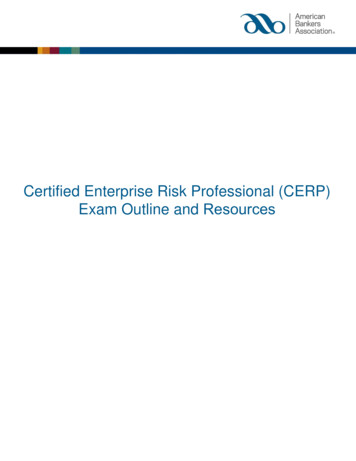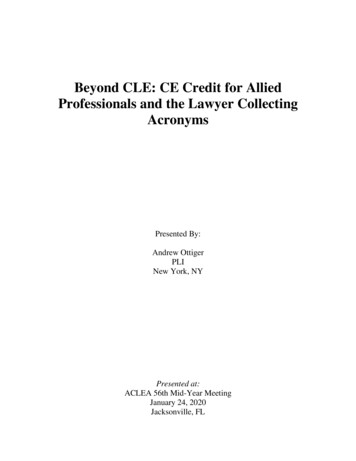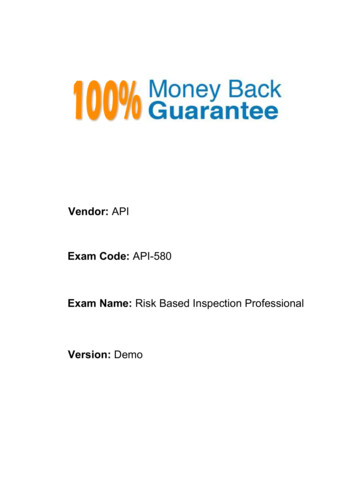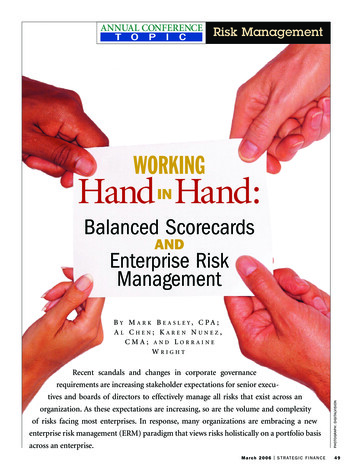
Transcription
Certified Enterprise Risk Professional (CERP)Exam Outline and Resources
ContentsSection 1: Risk Governance . 2Domain 1: Board and Senior Management Oversight (8%). 2DOMAIN 1 – Resources . 3Domain 2: Policies, Procedures, and Limits (15%) . 4DOMAIN 2 – Resources. 6Domain 3: Management Information Systems (9%) . 8DOMAIN 3 – Resources . 9Domain 4: Control Framework (10%) .10DOMAIN 4 – Resources.11Section 2: Risk Management.13Domain 5: Risk Identification (12%) .13DOMAIN 5 – Resources.15Domain 6: Risk Measurement and Evaluation (17%) .16DOMAIN 6 – Resources.17Domain 7: Risk Mitigation (17%) .18DOMAIN 7 – Resources.20Domain 8: Risk Monitoring (12%) .24DOMAIN 8 – Resources.25Appendix: Key Measures of Credit, Financial, and Non‐Financial Risk .27Key Credit Risk Measures .27Key Financial Risk Measures .28Key Non-Financial Risk Measures .291
Section 1: Risk GovernanceDomain 1: Board and Senior Management Oversight (8%)Task 1: Provide relevant, timely, and accurate information to board and senior management.Knowledge of:a. Procedures to manage and report the status of risk identification, measurement, and controlactivitiesb. The concepts and components of risk appetite and risk culture and how they link to corporatestrategy and operationsc.The concept of credible challenge by the boardTask 2: Champion policies, risk appetite, and risk culture across the organization.Knowledge of:a. Methods to manage organizational, process, and cultural changeb. The concepts and components of risk appetite and risk culture and how they link to corporatestrategy and operationsc.Practices to educate and increase awareness of risk policies, appetite, and culture within andacross all three lines of defenseTask 3: Direct information to the appropriate board and/or management risk committees.Knowledge of:a. Organizational structures and committees, and their roles and responsibilitiesb. The concepts and components of risk appetite and risk culture and how they link to corporatestrategy and operationsc.The concept of credible challenge by the board2
DOMAIN 1 - Study ResourcesJournal ReferencesIT Governance Institute. Information Security Governance: Guidance for Boards of Directors 2nd Edition.Regulation/Standard ReferencesOCC. Interest Rate Risk - Comptroller's Handbook.COSO - The Committee of Sponsoring Organizations of the Treadway Commission. Effective EnterpriseRisk Oversight - The Role of the Board of Directors.Federal Reserve Board of Governors. SR 16-11 Supervisory Guidance for Assessing Risk Managementat Supervised Institutions with Total Consolidated Assets Less than 50 Billion.The Office of the Comptroller of the Currency. 12 CFR Parts 30 and 170: OCC Guidelines EstablishingHeightened Standards.The Office of the Comptroller of the Currency. OCC Comptroller's Handbook - Corporate and RiskGovernance.COSO. Enterprise Risk Management - Integrated Framework – 2004OCC. Retail Lending - Comptroller's Handbook.3
Domain 2: Policies, Procedures, and Limits (15%)Task 1: Establish and maintain enterprise risk management policies in alignment with enterprisegoals and objectives.Knowledge of:a. Elements of a good control environmentb. Business performance relative to policy limits and the implications this has for the effectivenessof the limits themselvesc. Regulatory expectations around policy constraintsd. How to identify current and emerging expectations in the regulatory environmente. Methods to implement and communicate enterprise risk management policies, standards,procedures, and guidelinesf. The importance of idiosyncratic risks to the businessg. The concepts of organizational control structure and escalation channelsh. The relationship between risk appetite and enterprise goals and objectivesi.Purpose of policies and guiding principles that policies should followj.The concepts and components of risk appetite and risk culture and how they link to corporatestrategy and operationsTask 2: Define and maintain enterprise risk management standards, guidelines, and proceduresto guide and enforce compliance.Knowledge of:a. Elements of a good control environmentb. Regulatory expectations around policy constraintsc.How to identify current and emerging expectations in the regulatory environmentd. The importance of idiosyncratic risks to the businesse. The concepts of organizational control structure and escalation channelsf.Elements of risk appetite and the relationship between risk appetite and enterprise goals andobjectivesg. Purpose of procedures and principles the procedures should followh. Expectations for policy, procedure, and limit reviewTask 3: Develop and maintain policy limits.Knowledge of:a. Business performance relative to policy limits and the implications this has for the effectivenessof the limits themselvesb. Regulatory expectations around policy constraintsc.How to identify current and emerging expectations in the regulatory environmentd. The importance of idiosyncratic risks to the businesse. Concept of risk appetite and its relationship to limit‐settingf.Purpose of, methodologies for establishing, and sound governance principles for limits4
g. Calculation of risk metrics/quantitative methodsh. Typical sources of risk concentrationTask 4: Establish risk appetite framework.Knowledge of:a. Elements of a good control environmentb. The importance of idiosyncratic risks to the businessc.Elements of risk appetite and the relationship between risk appetite and enterprise goals andobjectivesTask 5: Administer and handle policy and standard exceptions.Knowledge of:a. Organizational structures, committees and their roles and responsibilities, and the concept ofescalationb. Documentation of policy and standard exceptions, including that the appropriate approvalauthority was used for the exceptionTask 6: Escalate risk to the appropriate governing body.Knowledge of:a. Corporate governance, organizational structures, committees, and their roles andresponsibilitiesb. Communication channels and techniquesc.Business writing and communication techniquesd. Documentation techniques and best practices5
DOMAIN 2 – Study ResourcesRegulation/Standard ReferencesOffice of the Comptroller of Currency. Loan Portfolio Management / Comptroller's HandbookOCC. Interest Rate Risk - Comptroller's Handbook.Board of Governors of the Federal Reserve System. SR 11-7 Supervisory Guidance on ModelRisk Management.Board of Governors of the Federal Reserve. SR 10-1 Interagency Advisory on Interest RateRisk.Office of Comptroller of the Currency (OCC). Allowance for Loan and Lease Losses,Comptroller's Handbook.Office of Comptroller of the Currency (OCC). Concentrations of Credit, Comptrollers Handbook.Federal Reserve, OCC, et. al. Joint Interagency Guidance on Interest Rate Risk.The Office of the Comptroller of the Currency. Capital Planning: OCC Bulletin 2012-16.Federal Reserve. SR 1215a1 - Federal Reserve Supervisory Letter.The Office of the Comptroller of the Currency. 12 CFR Parts 30 and 170: OCC GuidelinesEstablishing Heightened Standards.The Office of the Comptroller of the Currency. OCC Comptroller's Handbook - Corporate andRisk Governance.The Office of the Comptroller of the Currency. OCC 2011-21: Interagency Guidance on theAMA for Operational Risk.The Office of the Comptroller of the Currency. OCC 2011-12: Supervisory Guidance on ModelRisk Management.6
OCC. Liquidity Safety and Soundness - Comptroller's Handbook.The Office of the Comptroller of the Currency. Interagency Supervisory Guidance onCounterparty Risk Management.OCC. Comptroller's Handbook: Rating Credit Risk. OCC.The Office of the Comptroller of the Currency. Comptroller's Handbook - Related Organizations.Federal Statutes ReferencesAppendix D to Part 30—OCC Guidelines Establishing Heightened Standards for Certain LargeInsured National Banks, Insured Federal Savings Associations, and Insured Federal Branches.12 CFR 30. [Docket ID OCC–2015–0017] 12 CFR 30, appendix D, II.J, “Risk Data Aggregationand Reporting.”.Part 206 - Regulations on Interbank Liabilities (Regulation F).Website ReferencesSecurities and m/dfast/FDIC. Vol 11 issue 2.Deloitte.7
Domain 3: Management Information Systems (9%)Task 1: Develop and maintain management information systems (reporting tools) tosystematically track and evaluate the performance of risk mitigation actions.Knowledge of:a. Risk aggregation analysis tools and processesb. How to manage risk effectively with existing system limitations and access restrictions (e.g.,manual vs. automated reporting)c. Methodologies for confirming and challenging the integrity of entries in the systemd. Information systems likely to be able to provide data required for risk reporting (e.g., assetliability systems)e. Collection, preservation, and presentation of evidence (completeness, quality, etc.)f.Design elements in MIS reports to board and senior management that escalate attention toimportant risk mitigation actionsTask 2: Assess the quality and capabilities of the MIS systems used to support the decision‐making activities of the institution.Knowledge of:a. Risk aggregation analysis tools and processesb. Industry standards, sound practices, and regulatory expectations regarding enterprise riskmanagementc. How to manage risk effectively with existing system limitations and access restrictions (e.g.,manual vs. automated reporting)d. Information systems likely to be able to provide data required for risk reporting (e.g., assetliability systems)e. Investigative techniques (inquire, observe, request documentation, challenge)Task 3: Ensure accuracy of data used for board and senior management reporting.Knowledge of:a. Risk aggregation analysis tools and processesb. Investigative techniques (inquire, observe, request documentation, challenge)c.Fundamental system requirements knowledge (e.g., asset liability system, modeling, credit risk,risk assessment)Task 4: Effectively manage data governance.Knowledge of:a. Risk aggregation analysis tools and processesb. Investigative techniques (inquire, observe, request documentation, challenge)c.Information systems likely to be able to provide data required for risk reporting (e.g., assetliability systems)d. Techniques for establishing quality control processes and accountability8
DOMAIN 3 - Study ResourcesBook ReferencesRossi, Clifford. 2014. A Risk Professional's Survival Guide. John Wiley & Sons .Regulation/Standard ReferencesFederal Reserve Board of Governors. SR 08-8 Compliance Risk Management Programs and Oversightat Large Banking Organizations with Complex Compliance Profiles.Basel Committee on Banking. Principles for Effective Data Aggregation and Risk Reporting.Office of Comptroller of Currency (OCC). Rating Credit Risk, Comptrollers Handbook.OCC. Corporate and Risk Governance. OCC.OCC. Third-Party Relationships.Office of the Comptroller Currency. Comptrollers Handbook: Corporate-Risk Governance. OCC.OCC. Comptroller's Handbook: Large Bank Supervision. OCC.Website ReferencesMcKinsey & Company.Protiviti KnowledgeLeader.Metric Stream.McKinsey.Deloitte.9
Domain 4: Control Framework (10%)Task 1: Determine if the internal control framework aligns with the size, complexity, and riskappetite of the organization.Knowledge of:a. Three lines of defense: roles, responsibilities, and the importance of an independent ERMfunctionb. System of internal controls, including control types and techniquesc. Control frameworks (e.g., COSO)d. Effective challenge by risk management staffe. Principles for conducting effective risk and control self‐assessments (RCSAs)f. Model risk management practicesTask 2: Coordinate timing, coverage, and scope of risk management reviews with those of othercontrol partners.Knowledge of:a. Three lines of defense: roles, responsibilities, and the importance of an independent ERMfunctionb. System of internal controls, including control types and techniquesc. Quality control and quality assuranceTask 3: Support effective exam management for regulators, independent third parties, and audit.Knowledge of:a. Three lines of defense: roles, responsibilities, and the importance of an independent ERMfunctionb. System of internal controls, including control types and techniquesc. Principles for effective exam management (e.g., regulatory and audit)Task 4: Assess the adequacy of controls around external financial reporting and disclosures.Knowledge of:a. Three lines of defense: roles, responsibilities, and the importance of an independent ERMfunctionb. System of internal controls, including control types and techniquesc. Sarbanes‐Oxley Act and financial review committeesd. Financial and regulatory reports and appropriate interpretatione. Control frameworks (e.g., COSO)f. Effective challenge by risk management staff10
DOMAIN 4 – Study Resources: Regulation/Standard ReferencesFederal Reserve Board of Governors. SR 11-7 Supervisory Guidance on Model Risk Mgmt.Federal Reserve Board of Governors. SR 16-11 Supervisory Guidance for Assessing Risk Managementat Supervised Institutions with Total Consolidated Assets Less than 50 Billion.Federal Reserve Board of Governors. SR 08-8 Compliance Risk Management Programs and Oversightat Large Banking Organizations with Complex Compliance Profiles.Federal Reserve Board of Governors. SR 04-18 Bank Holding Company Rating System.Federal Reserve Board of Governors. Bank Holding Company Supervision Manual.Federal Reserve Board of Governors. SR 13-01 Supplemental Policy on Internal Audit /Outsourcing.Board of Governors of the Federal Reserve System. SR 92-28 Interagency Guidance on Coordinationand Communication Between External Auditors and Examiners.Board of Governors of the Federal Reserve. Commercial Bank Examination Manual.Board of Governors of the Federal Reserve. SR 96-37 Supervisory Guidance on Required Absences fromSensitive Positions.Board of Governors of the Federal Reserve. SR 13-13 / CA 13-10: Supervisory Considerations for theCommunication of Supervisory Findings.Board of Governors of the Federal Reserve. SR 05-4 Interagency Advisory on the Confidentiality ofNonpublic Supervisory Information.Board of Governors of the Federal Reserve. SR 15-16: Enhancements to the Federal Reserve System'sSurveillance Program.National Information Center of the Board of Governors of the Federal Reserve. BHCPR Peer GroupAverage Reports.Board of Governors of the Federal Reserve System. SR 96-26 Provision of Individual Components ofSupervisory Rating Systems to Management and Boards of Directors.Board of Governors Federal Reserve System. SR 96-38 Uniform Financial Institutions Rating System.11
Board of Governors of the Federal Reserve. SR 94-12 The Federal Reserve System's Definition of a FullScope, On-Site Examination for Safety and Soundness.Board of Governors of the Federal Reserve. SR 17-12: Timing Expectations for the Completion of Safetyand-Soundness Examination and Inspection Reports for Regional Banking Organizations.Board of Governors Federal Reserve System. SR 93-59 Interagency Uniform Core Examination Report.Board of Governors of the Federal Reserve. SR 16-14: FFIEC Information Technology ExaminationHandbook – Information Security Booklet.Federal Financial Institutions Examination Council. FFIEC iT Examination Handbook Infobase.Board of Governors Federal Reserve. SR 13-19 / CA 13-21: Guidance on Managing Outsourcing Risk.Board of Governors of the Federal Reserve. Federal Reserve Purposes and Functions.Electronic Code of Federal Regulations. Enhanced Prudential Standards (Regulation YY).Basel Committee of the Bank of International Settlements. Basel Regulatory Framework.Board of Governors of the Federal Reserve System. Stress Tests and Capital Planning.Board of Governors of the Federal Reserve System. Resolution Plans.Board of Governors of the Federal Reserve. SR 17-11: Interagency Frequently Asked Questions onImplementation of the Liquidity Coverage Ratio (LCR) Rule.Board of Governors of the Federal Reserve. 14-3: Supervisory Guidance on Dodd-Frank Act CompanyRun Stress Testing for Banking Organizations with Total Consolidated Assets of More Than 10 Billionbut Less Than 50 Billion.Board of Governors of the Federal Reserve. SR 10-1 Interagency Advisory on Interest Rate Risk.Board of Governors of the Federal Reserve. SR 16-12: Interagency Guidance on the New AccountingStandard on Financial Instruments – Credit Losses.PCAOB. An Audit of Internal Control Over Financial Reporting That Is Integrated with An Audit ofFinancial Statements.12
Section 2: Risk ManagementDomain 5: Risk Identification (12%)Task 1: Monitor and survey the internal and external environment for emerging risks and, wherenecessary, identify and execute appropriate risk mitigating strategies.Knowledge of:a. Likelihood, impact, direction, and velocity for assessing risksb. Types of risk events (across risk taxonomies)c.Potential upstream/downstream impact of risk eventsd. Criteria for criticalitye. Regulatory environment and applicable requirementsf.Internal risk appetite and toleranceg. Basic processes and principles of bankingTask 2: Aid the first line in properly identifying, scoping, and conducting comprehensive riskand control self‐assessments (RCSAs).Knowledge of:a. Likelihood, impact, direction, and velocity for assessing risksb. Types of risk events (across risk taxonomies)c.Potential upstream/downstream impact of risk eventsd. Criteria for business criticalitye. Risk and control self‐assessment (RCSA) scopingf.Regulatory environment and applicable requirementsg. Risk appetite and toleranceh. Basic processes and principles of bankingTask 3: Identify key risks associated with non‐compliance with internal and externalexpectations.Knowledge of:a. Likelihood, impact, direction, and velocity for assessing risksb. Types of risk events (across risk taxonomies)c.Potential upstream/downstream impact of risk eventsd. Criteria for business criticalitye. Regulatory environment and applicable requirementsf.Risk appetite and toleranceg. Basic processes and principles of banking13
Task 4: Identify key idiosyncratic risks.Knowledge of:a. Likelihood, impact, direction, and velocity for assessing risksb. Types of risk events (across risk taxonomies)c.Potential upstream/downstream impact of risk eventsd. Criteria for business criticalitye. Regulatory environment and applicable requirementsf.Risk appetite and toleranceg. Basic processes and principles of bankingTask 5: Identify risk scenarios that could lead to business loss.Knowledge of:a. Likelihood, impact, direction, and velocity for assessing risksb. Types of risk events (across risk taxonomies)c.Potential upstream/downstream impact of risk eventsd. Criteria for business criticalitye. Regulatory environment and applicable requirementsf.Risk appetite and toleranceg. Basic processes and principles of banking14
DOMAIN 5 – Study ResourcesBook ReferencesRossi, Clifford. 2014. A Risk Professional's Survival Guide. John Wiley & Sons.Anthony Saunders and Marcia Millon Cornett. MCGraw-Hill Irwin. Financial Markets and Institutions.Regulation/Standard ReferencesFederal Reserve Board of Governors. SR 16-11 Supervisory Guidance for Assessing Risk Management atSupervised Institutions with Total Consolidated Assets Less than 50 Billion.The Office of the Comptroller of the Currency. Risk Management Guidance: Third Party Relationships,Bulletin 2013-29.FDIC. Supervisory Guidance on Operational Risk Advanced Measurement Approaches for RegulatoryCapital.Website cial Stability Board ommunitybanks/15
risk.aspStephen Cross, Senior Director, Wolters Kluwer Financial Services and Thomas Grundy, SeniorConsultant, Wolters Kluwer Financial Services.Julie verwyman/global/en/2015/may/Oliver Wyman Risk nual/yokin e/y07.pdf16
Domain 6: Risk Measurement and Evaluation (17%)Task 1: Estimate the likelihood that an event will occur and the impact of an event if it occurs.Knowledge of:a. Key credit, financial, and non‐financial risk measures (see Appendix for risk measures)b. Evaluation of inherent risk, control environment, and residual riskc. Calculation of risk metrics/quantitative methodsd. Key indicators of economic trends (e.g., unemployment, bankruptcy rate, etc.)e. Typical sources of risk concentrationTask 2: Effectively challenge risk metric calculations by others.Knowledge of:a. Key credit, financial, and non‐financial risk measures (see Appendix for risk measures)b. Calculation of risk metricsTask 3: Conduct scenario analysis stress tests.Knowledge of:a. Key credit, financial, and non‐financial risk measures (see Appendix for risk measures)b. Calculation of risk metricsc.Types of events that should be used in stress testing and the limitations of these scenarioanalysesd. Key indicators of economic trends (e.g., unemployment, bankruptcy rate, etc.)Task 4: Complete risk and control self‐assessments (RCSAs).Knowledge of:a. Key credit, financial, and non‐financial risk measures (see Appendix for risk measures)b. Evaluation of inherent risk, control environment, and residual riskc.Calculation of risk metricsTask 5: Evaluate risk relative to risk appetite and risk tolerance.Knowledge of:a. Key credit, financial, and non‐financial risk measures (see Appendix for risk measures)b. Risk appetite and tolerancec. Calculation of risk metricsd. Typical sources of risk concentrationTask 6: Perform root cause analysis.Knowledge of:a. Effects of diversification or amplification on aggregated risksb. Typical sources of risk concentrationc. How risk appetite is quantified by risk types (for aggregation purposes)d. Root cause analysis principles and techniquesTask 7: Aggregate like risks.Knowledge of:a. Effects of diversification or amplification on aggregated risksb. How risk appetite is quantified by risk types (for aggregation purposes)Task 8: Aggregate across multiple risk types.Knowledge of:a. Effects of correlation on diversification and aggregated risks17
DOMAIN 6 – Study ResourcesBook ReferencesJorion, Philippe (2006). McGraw-Hill. Value at Risk: The New Benchmark for Managing Financial Risk(3rd ed.).Regulation/Standard ReferencesOffice of the Comptroller of the Currency. Comptroller's Handbook - Bank Supervision Process.OCC. Interest Rate Risk - Comptroller's Handbook.Federal Reserve Board of Governors. SR 16-11 Supervisory Guidance for Assessing Risk Managementat Supervised Institutions with Total Consolidated Assets Less than 50 Billion.Basel Committee on Banking. Principles for Effective Data Aggregation and Risk Reporting.Board of Governors of the Federal Reserve System. Stress Tests and Capital Planning.Board of Governors of the Federal Reserve. FR Y9-C Instructions for Preparation of ConsolidatedFinancial Statements for Holding Companies.OCC. Comptroller's Handbook: Commercial Real Estate Lending.The Office of the Comptroller of the Currency. 12 CFR Parts 30 and 170: OCC Guidelines EstablishingHeightened Standards.OCC. "Community Bank Stress Testing: Supervisory Guidance". OCC.OCC. Liquidity Safety and Soundness - Comptroller's Handbook.OCC. Comptrollers Handbook: Concentrations Of Credit.OCC. Asset Based Lending - Comptroller's Handbook.Federal Reserve/FDIC/OCC/OTS. INTERAGENCY GUIDANCE ON THE ADVANCED MEASUREMENTAPPROACHES FOR OPERATIONAL RISK.Basel Committee on Banking Supervision. Basel III: The Liquidity Coverage Ratio and liquidity riskmonitoring tools.OCC. Residential Real Estate - Comptroller's Handbook.Federal Reserve. Supervisory Policy and Guidance Topics - Market Risk Management.18
Federal Financial Institutions Examination Council. FFIEC Information Technology ExaminationHandbook - Management.FDIC. FDIC Compliance Examination Manual.Federal Statutes ReferencesAppendix D to Part 30—OCC Guidelines Establishing Heightened Standards for Certain Large InsuredNational Banks, Insured Federal Savings Associations, and Insured Federal Branches. 12 CFR 30.[Docket ID OCC–2015–0017] 12 CFR 30, appendix D, II.J, “Risk Data Aggregation and Reporting.”.Website outthefed/liquidity stress n/global/en/2015/dec/OW reserve.gov/supervisionreg/topics/asset quality.htmFinancial Stability Board (FSB).Chartered Institute of Internal Auditors.Stephen Cross, Senior Director, Wolters Kluwer Financial Services and Thomas Grundy, SeniorConsultant, Wolters Kluwer Financial onic Media ReferencesThe Office of the Comptroller of the Currency (OCC). ENTERPRISE RISK APPETITE STATEMENT. April2016.19
Domain 7: Risk Mitigation (17%)Task 1: Evaluate the appropriateness of management’s risk response and documentation.Knowledge of:a. Types of risk responses (accept, mitigate, transfer, avoid)b. Basic classes of risk transfer instruments, including insurance and securitized assets,and when they are appropriate to usec. Practices for mitigating counterparty risk in risk transferd. Root cause analysis and after action reviewse. Documentation expectationsTask 2: Prepare proper action plans for possible events.Knowledge of:a. Types and examples of risk responses (accept, mitigate, transfer, avoid), and when eachis appropriateb. Root cause analysis and after action reviewsc. Third‐party risk management practicesd. Risk appetite and toleranceTask 3: Select or recommend appropriate types of risk mitigation activity.Knowledge of:a. Types of risk responses (accept, mitigate, transfer, avoid)b. Basic classes of risk transfer instruments, including insurance and securitized assets,and when they are appropriate to usec. Practices for mitigating counterparty risk in risk transferd. Root cause analysis and after action reviewse. Third‐party risk management practicesf. Risk appetite and toleranceTask 4: Respond to incidents with timely and appropriate mitigation.Knowledge of:a. Types of risk responses (accept, mitigate, transfer, avoid)b. Root cause analysis and after action reviewsTask 5: Perform issue management, including identification and tracking, to ensureeffective and timely resolution.20
Knowledge of:a. Types of risk responses (accept, mitigate, transfer, avoid)b. Root cause analysis and after action reviewsc. Effective issue managementTask 6: Respond to findings from regulators, independent third parties, and audit.Knowledge of:a. Types of risk responses (accept, mitigate, transfer, avoid)b. Root cause analysis and after action reviewsc. Effective finding managementTask 7: Estimate the residual risk of an event post‐mitigation.Knowledge of:a. Evaluation of inherent risk, control environment, and residual riskb. Calculation of risk metricsDOMAIN 7 – Study ResourcesBook ReferencesBasel Committee on Banking Supervision. Bank for International Settlements. 2011. Principles for theSound Management of Operational Risk and the Role of Supervision. Basel, Switzerland.Regulation/Standard ReferencesBOARD OF GOVERNORS OF THE FEDERAL RESERVE SYSTEM. Supervisory Guidance RegardingCounterparty Credit Risk Management.OCC. Liquidity Coverage Ratio: Liquidity Risk Measurement Standards.COSO - The Committee of Sponsoring Organizations of the Treadway Commission. Effective EnterpriseRisk Oversight - The Role of the Board of Directors.Office of the Comptroller of
d. Information systems likely to be able to provide data required for risk reporting (e.g., asset liability systems) e. Investigative techniques (inquire, observe, request documentation, challenge) Task 3: Ensure accuracy of data used for board and senior management reporting. Knowledg










